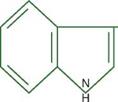 OBJECTIVES
OBJECTIVES
Upon completion of this chapter, you should be able to
• list at least three different types of naturally occurring growth regulators and their effects on plants.
• list several commercial products that regulate plant growth.
KEY TERMS
 parthenocarpy parthenocarpic fruit cytokinins kinetin
parthenocarpy parthenocarpic fruit cytokinins kinetin
GROWTH REGULATORS DEFINED
Green plants contain a number of organic compounds that control plant growth. These compounds are present only in minute amounts, yet they stimulate, inhibit, and otherwise modify the rate, the direction, and the nature of plant development. The compounds that occur naturally are called hormones. They may be produced in one part of the plant, yet exert their effect in another part, far removed from the source. Still other modifiers of plant development are synthesized by chemists and made available to commercial horticulturists for the production of more desirable crops. All of the products, either naturally occurring or commercially synthesized, are given the name of growth regulators.
TYPES OF GROWTH REGULATORS__________________
Most plant scientists would agree that our knowledge of plant growth regulators is still incomplete. The regulators have probably not all been 66 isolated; their effects at different concentrations vary; their effects in
different species of plants vary; and even the sites of their production and activity within plants vary. At present, we have a fair knowledge of auxins, gibberellins, and cytokinins. We have a limited knowledge of several others.

 Auxins
Auxins
Auxins are plant hormones that both promote and inhibit plant growth. Indoleacetic acid (IAA) is the most commonly occurring natural auxin (Figure 4-1). Auxins have been found responsible for phototropism, geotropism, and apical dominance.
Our knowledge of auxins began with the curiosity of scientists who wondered why stems grow up and roots grow down, why plant stems seem to bend toward the light, and why the removal of an apical (or terminal) bud stimulates the growth of lateral buds beneath it. Studies with the sheathlike covering (coleoptile) of the young stem of oat seedlings (Avena) have provided the evidence on which our understanding of auxins is based.
Seedlings exposed to light from only one side bend toward the light source. Charles Darwin first recorded the observation that seedlings bend toward the light only if the tips are exposed. When the seedling tips are covered with caps that do not allow the passage of light, the seedling tips do not bend (Figure 4-2). The conclusion drawn from Darwin’s studies was that a substance produced in the tips can exert an influence on the growth of tissue some distance from the tip. Such a conclusion is compatible with the definition of a hormone.
 |
Researchers after Darwin continued to experiment. In one experiment, the tips of seedlings were removed, a bit of gelatin was added to each cut stump, and the tips were replaced. The seedlings still bent toward a unilateral light source. When the tips were not replaced, the seedlings did not bend (Figure 4-3). The conclusion was that whatever accelerated the growth on the unlighted side of the stem was able to diffuse through the gelatin.
![]()
![]()
![]()

 |
Dark
figure 4-4. The Avena (oat) coleoptile test: Coleoptiles that are kept in the dark do not bend (A). If their tips are removed and then replaced on one side (B), coleoptile curvature will result, and it will be away from the side holding the tip (C). (Delmar/Cengage Learning)
eral buds and shoots are allowed to grow. The horticultural practice of pruning to promote denser growth involves overcoming apical dominance by removing the tips of branches.
Auxins are present in plant roots as well as in shoots. The research of K. V. Thimann provided evidence that roots are much more sensitive than shoots to auxin. The same amount of auxin that promotes cell elongation in shoots can inhibit growth in roots (Figure 4-5).
The ability of auxin to promote and inhibit plant growth explains why shoots grow upward and roots grow downward (Figure 4-6). When a coleoptile or stem is placed in a horizontal position, auxin accumulates in higher concentrations on the lower side of the plant. The auxin causes the cells on the underside of the shoot to elongate faster than the cells on the upper side, so the shoot grows upward. The same concentration of auxin inhibits the growth of the cells on the lower side of the roots, allowing the cells on the upper surface to grow faster and direct the root downward. The response of auxin to gravity and the resulting growth reaction in plants is termed geotropism.
 |
 |
The mechanism of auxin action is not fully understood, although several theories exist. One line of research has correlated the presence of auxin with the production of ethylene in plants. Since some of the responses associated with auxins can be duplicated by exposing the plants to ethylene, the theory is that the growth responses attributed to auxins actually result from ethylene produced through the auxin presence. Another theory is that auxin increases the plasticity of the cell walls, permitting the cells to expand to larger sizes. Still another theory is that auxin increases the energy supply in the tissue where it is present, and this increased metabolic activity stimulates plant growth.
figure 4-5. Auxin concentrations needed to figure 4-6. The response of auxin to gravity explains why
promote growth vary in different parts of the shoots grow upward and roots downward. (Delmar/Cengage
plant. If concentrations are altered, growth can Learning) be inhibited. (Delmar/Cengage Learning)

